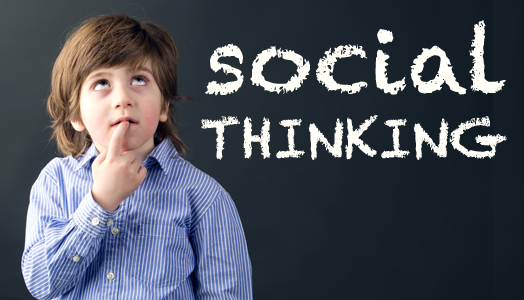Social Thinking!
Social Thinking is what we do when we interact with people. What do we do when we interact with people? We think about THEM and they think about US! How others think about us affects how we behave. This in turn affects how others respond to us and our emotions.
Consider the following…
You as an adult attend a very boring business meeting. Do you yawn, lay down your head, and go to sleep? No!
Why? You want colleagues to keep having good thoughts about you. Consider your drive home from work. How many times do you replay the attitudes, thoughts, and behavior of those around you? Think about your child with social challenges: how many times a day do you suppose he or she has the same thoughts? Probably not too often!
A treatment framework and curriculum founded and developed by Michelle Garcia Winner, M.S. CCC-SLP, targets improving individual social cognitive abilities. Many students score high on IQ and standardized tests, yet do not intuitively learn the ins and outs of social communication. Social cognitive challenges are commonly experienced by individuals with Autism Spectrum disorders (high-functioning), Social Communication Disorder, Social Anxiety, Attention Deficit Disorder, Nonverbal Learning Disability (NLD) and similar diagnoses. Others experience social learning difficulties even with no diagnosis. Social Thinking lessons help students to improve relationships with peers and adults. Students also boost their skills related to speaking and listening included in the Common Core Performance Standards for education. Students acquire strategies to improve perspective taking, problem solving, and emotional regulation. Often children have “graduated” from traditional speech and language therapy but require more training in using language to communicate effectively. Social Thinking is different from traditional ABA style therapy as the clinician and student explore how to “think” socially before attempting how to “act” socially.
Michelle Garcia Winner and her staff developed the core vocabulary of Social Thinking, such as: Whole Body Listening (often referred to as “active listening”), Expected and Unexpected behaviors (often referred to as “appropriate and inappropriate” behaviors), and Think With Your Eyes (often referred to as using eye contact). The vocabulary is easily understood and accepted by students and can be introduced to classroom teachers to help generalize learning. The “Superflex” curriculum was developed for 8-11 year olds and introduces “Superflex” (the hero) and the “Unthinkables” (the villains who invade the brains of our students coaxing them to make poor choices related to social skills) through stories and activities. For example, “Rock Brain” tells the child to think about only what he wants to do and not to consider the group (get stuck on your own plan). “One-Sided Sid” tells a child to talk and think about only what he wants to talk and think about. “Body Snatcher” makes the child move his body from the group.
“The Incredible Flexible You” program was designed for 4-7 year olds to teach emotions, play skills, following the group plan, and what behaviors are “expected” and “unexpected” in different circumstances through stories, play, and music.
Social Thinking lessons make the subject of social skills and pragmatic language easily accessible and fun for children. These lessons can be delivered in small group or individual sessions. Want to learn more? www.socialthinking.com.
This blog was adapted from Michelle GarciaWinner’s “Social Thinking.” ®
Amy Squires
M.S. CCC-SLP
Speech and Language Pathologist

